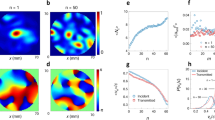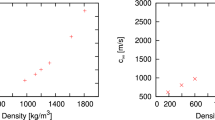Abstract
WE had observed1 that the heat generated by ultrasonic waves in carbon disulphide and in other liquids, such as toluene and xylene, is not in conformity with their widely divergent absorption coefficients as measured by other (acoustic) methods. To clarify the point further, we have made a set of measurements with the type of apparatus described in ref. l.
Similar content being viewed by others
Article PDF
References
Dutta, A. K., and Samal, K., Nature, 174, 976 (1954); 179, 95 (1957).
Hubbard, J. C., Fitzpatrick, P. A., Kankovsky, B. T., and Thaler, W. J., Phys. Rev., 74, 107 (1948).
Richardson, E. G., Proc. Roy. Soc., A, 146, 56 (1934).
Author information
Authors and Affiliations
Rights and permissions
About this article
Cite this article
DUTTA, A., SAMAL, K. Propagation of Ultrasonic Waves in Liquids. Nature 181, 563 (1958). https://doi.org/10.1038/181563a0
Issue Date:
DOI: https://doi.org/10.1038/181563a0
This article is cited by
-
Propagation of Ultrasonic Waves in Liquids
Nature (1959)
Comments
By submitting a comment you agree to abide by our Terms and Community Guidelines. If you find something abusive or that does not comply with our terms or guidelines please flag it as inappropriate.



